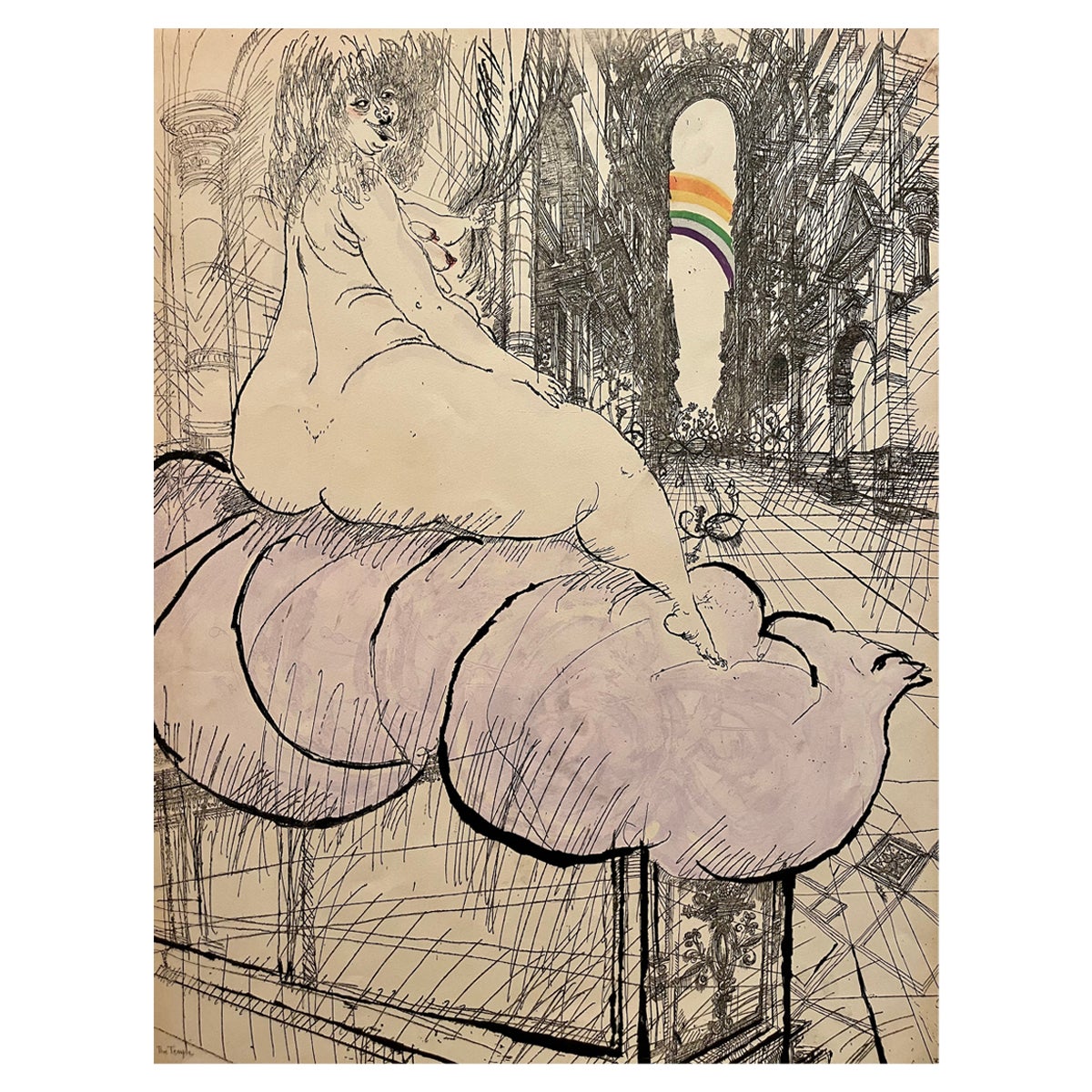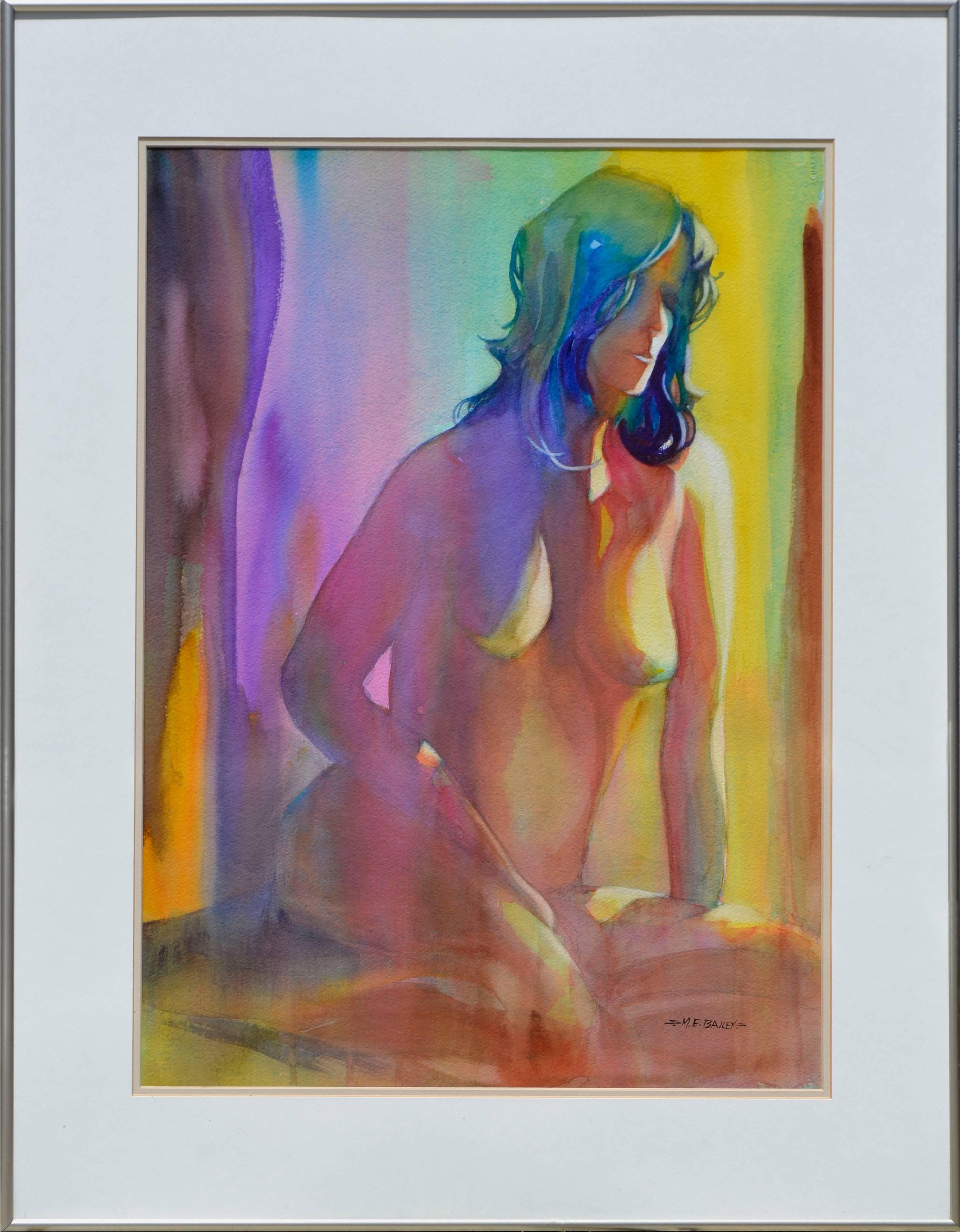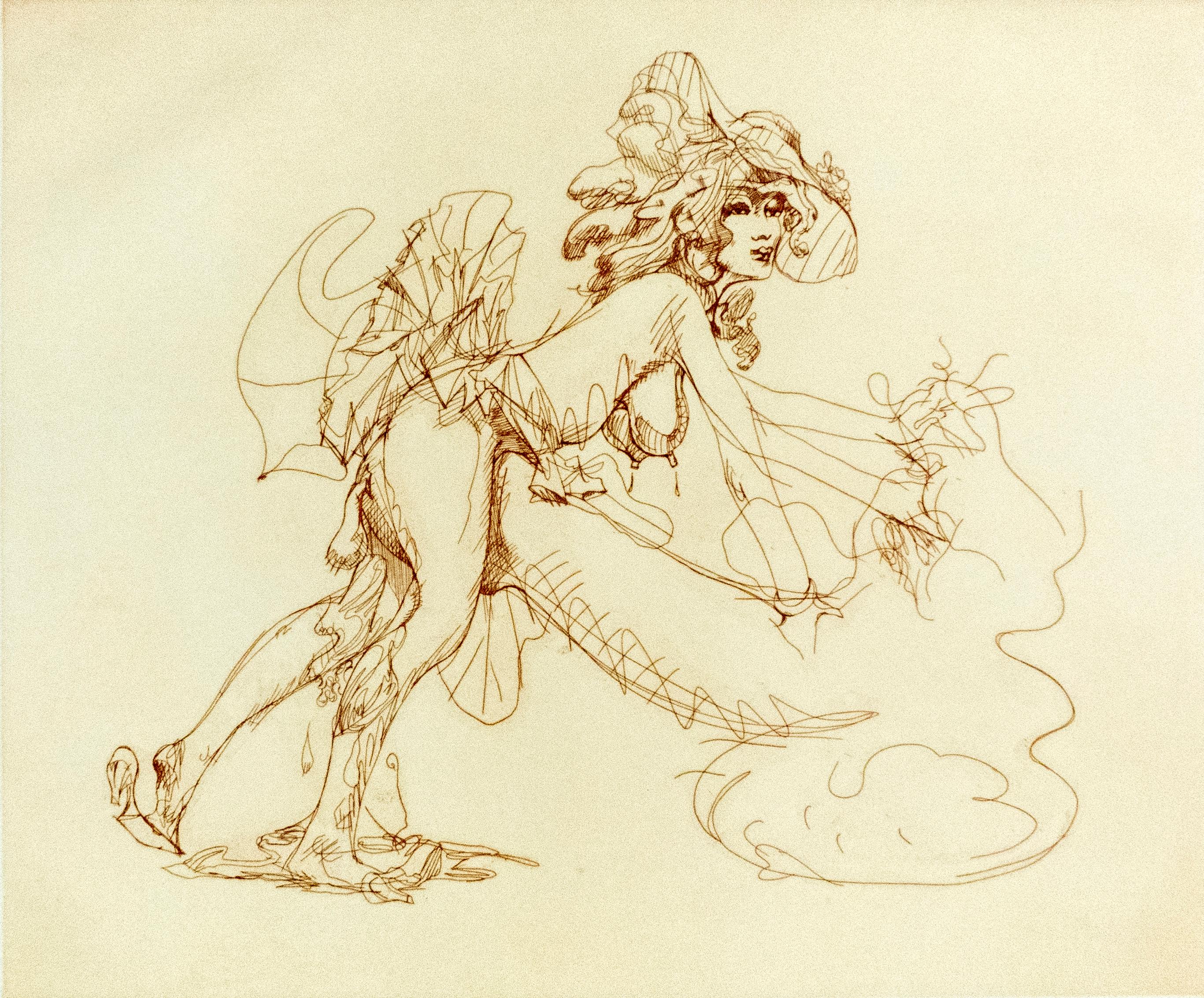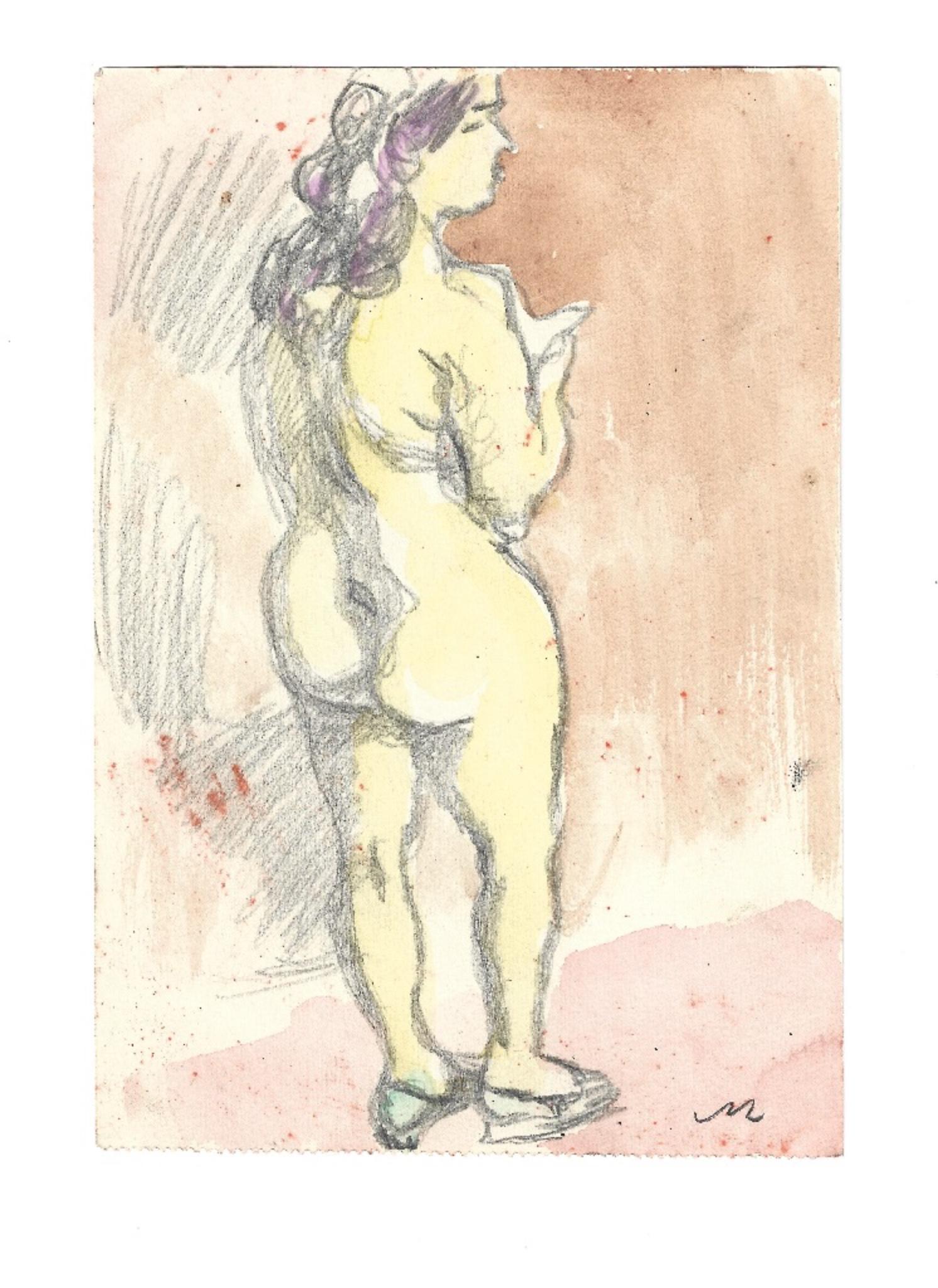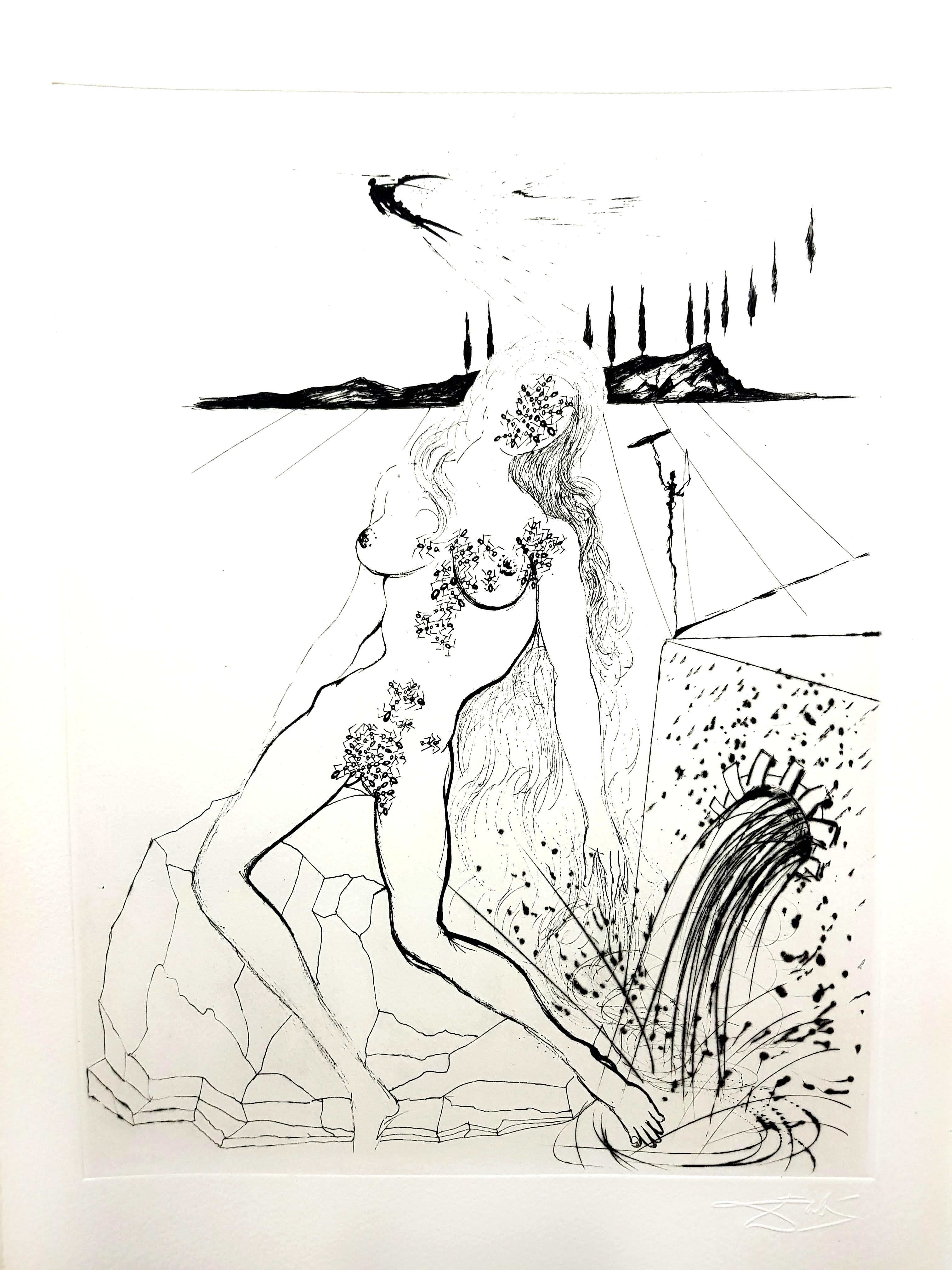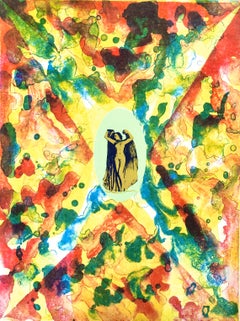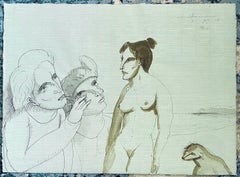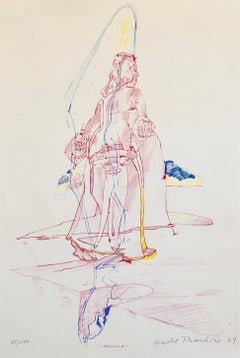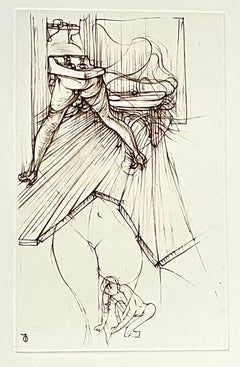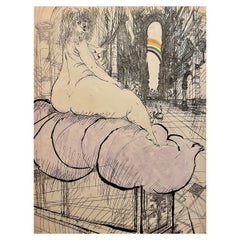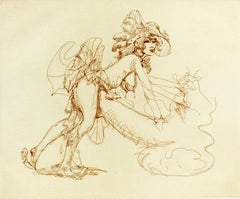Items Similar to The Temple, Large Nude Woman with Rainbow Ralph Steadman
Want more images or videos?
Request additional images or videos from the seller
1 of 10
Ralph SteadmanThe Temple, Large Nude Woman with Rainbow Ralph Steadman
$1,200
£909.23
€1,043.27
CA$1,688.59
A$1,856.23
CHF 975.55
MX$22,541.38
NOK 12,169.73
SEK 11,529.96
DKK 7,786.16
About the Item
Ralph Steadman (born 15 May 1936) is a British artist best known for his work with American author Hunter S. Thompson.
Steadman was born in Wallasey, Cheshire, and brought up in Abergele, North Wales. From a lower middle class background, his father was a commercial traveller and his mother was a shop assistant at T J Hughes in Liverpool. Steadman attended East Ham Technical College and the London College of Printing during the 1960s, doing freelance work for Punch, Private Eye, the Daily Telegraph, The New York Times and Rolling Stone during this time. He is a patron of the Association of Illustrators. Steadman currently lives with his wife in Kent, England.
Steadman is renowned for his political and social caricatures, cartoons and picture books. Awards that he has won for his work include the Francis Williams Book Illustration Award for Alice in Wonderland, the American Society of Illustrators' Certificate of Merit, the W H Smith Illustration Award for I Leonardo, the Dutch Silver Paintbrush Award for Inspector Mouse, the Italian Critica in Erba Prize for That's My Dad, the BBC Design Award for postage stamps, the Black Humour Award in France, and several Designers and Art Directors Association Awards. He was voted Illustrator of the Year by the American Institute of Graphic Arts in 1979.
Steadman's film poster for Where the Buffalo Roam.
Steadman had a long partnership with the American journalist Hunter S. Thompson, drawing pictures for several of his articles and books. He accompanied Thompson to the Kentucky Derby for an article for the magazine Scanlan's, to the Honolulu Marathon for the magazine Running, and illustrated both Fear and Loathing in Las Vegas and Fear and Loathing on the Campaign Trail '72. Much of Steadman's artwork revolves around Raoul Duke-style caricatures of Thompson: bucket hats, cigarette holder and aviator sunglasses.
Steadman appears on the second disc of The Criterion Collection Fear and Loathing in Las Vegas DVD set, in a documentary called Fear and Loathing in Gonzovision, which was made by the BBC in 1978, of Thompson planning the tower and cannon that his ashes were later blasted out of. The cannon was atop a 153-ft. tower of Thompson's fist gripping a peyote button; Thompson demands that Steadman gives the fist two thumbs, "Right now."
As well as writing and illustrating his own books and Thompson's, Steadman has worked with writers including Ted Hughes, Adrian Mitchell and Brian Patten, and also illustrated editions of Alice in Wonderland, Treasure Island, Animal Farm, the English translation of Flann O'Brien's Gaelic-language classic The Poor Mouth, and most recently, Fahrenheit 451.
Among the British public, Steadman is well known for his illustrations for the catalogues of the off-licence chain Oddbins and he designed a set of four British postage stamps to commemorate the appearance of Halley's Comet in 1985. He also designed the labels for Flying Dog beer and Cardinal "Spiced" Zin' wine, which was banned in Ohio for Steadman's "disturbing" interpretation of a Catholic cardinal on its label.
Steadman also illustrated Will Self's column in The Independent newspaper. Hal Willner and Johnny Depp's anthology of songs, Rogue's Gallery: Pirate Ballads, Sea Songs, and Chanteys (2006) contains two contributions from Steadman; he sings lead on "Little Boy Billee", and sings backing vocals on Eliza Carthy's song "Rolling Sea".
He has also drawn covers for numerous music artists, including the Who, Frank Zappa and Ambrosia, and the lead banner for the gonzo journalism website GonzoToday..
In 2011, Steadman began running prose and poetry in Kotori Magazine.
He also contributed to the BirdLife International's Preventing Extinctions programme with an image of critically endangered northern bald ibis.
A major documentary about Steadman's career, For No Good Reason, directed by Charlie Paul, played at the 2013 Toronto International Film Festival in the "Mavericks" programme. The film, reportedly 15 years in the making, played in New York City and Los Angeles in December 2013, and was given US domestic release in spring 2014. The film was in competition for the Grierson Award for Best Documentary at the 2012 BFI London Film Festival.
- Creator:Ralph Steadman (1936, British)
- Dimensions:Height: 33 in (83.82 cm)Width: 25.5 in (64.77 cm)Depth: 1 in (2.54 cm)
- Medium:
- Movement & Style:
- Period:
- Condition:
- Gallery Location:Surfside, FL
- Reference Number:1stDibs: LU38211190852
Ralph Steadman
Ralph Idris Steadman (born 15 May 1936) is a British artist and cartoonist whose style is defined by energetic ink splatters and grotesque, natty figures, known for his collaboration with American author and journalist Hunter S. Thompson. Steadman works with pen and brush in ink, also using acrylic and oil paint, etching, silk screen, and collage. Distinctive visual language along with his political and social caricatures, cartoons and picture books made Steadman one of the most popular artists of the 20th century.
About the Seller
4.9
Platinum Seller
Premium sellers with a 4.7+ rating and 24-hour response times
Established in 1995
1stDibs seller since 2014
1,810 sales on 1stDibs
Typical response time: 1 hour
- ShippingRetrieving quote...Shipping from: Surfside, FL
- Return Policy
Authenticity Guarantee
In the unlikely event there’s an issue with an item’s authenticity, contact us within 1 year for a full refund. DetailsMoney-Back Guarantee
If your item is not as described, is damaged in transit, or does not arrive, contact us within 7 days for a full refund. Details24-Hour Cancellation
You have a 24-hour grace period in which to reconsider your purchase, with no questions asked.Vetted Professional Sellers
Our world-class sellers must adhere to strict standards for service and quality, maintaining the integrity of our listings.Price-Match Guarantee
If you find that a seller listed the same item for a lower price elsewhere, we’ll match it.Trusted Global Delivery
Our best-in-class carrier network provides specialized shipping options worldwide, including custom delivery.More From This Seller
View All1970s Surrealist Pop Art Nude Angel Lithograph Print Psychedelic Color
Located in Surfside, FL
Hand Signed verso D. Herbert and numbered 1 of 20. (possibly Don Herbert)
Category
20th Century Pop Art Abstract Prints
Materials
Lithograph
Modern Figurative Surrealism Watercolor Painting, Drawing - Women On The Beach
By Gary Hansmann
Located in Surfside, FL
Gary Hansmann (1947-2008) was active/lived in California. He is known for abstract, Surrealism figure painting.
Gary William Hansmann was born Dec. 4, 1940, in San Diego to Ethel May...
Category
Late 20th Century Surrealist Figurative Paintings
Materials
Paper, India Ink, Watercolor
1970s Modernist Swiss Colorful Surrealism Signed Dada Lithograph Andre Thomkins
By André Thomkins
Located in Surfside, FL
This one is titled "Halemaid" and depicts a surreal figure of a robed woman in yellow red and blue with a Salvador Dali esque quality about it.
Published by Edition Hansjörg Mayer, Stuttgart They published concrete poetry and art books by Mark Boyle, Richard Hamilton, Dorothy Iannone, John Latham, Tom Phillips, Dieter Roth, André Thompkins and Emmett Williams, to name just a few.
André Thomkins (1930 - 1985) was a Swiss painter, illustrator, and poet. He attended art-school, taught by Max von Moos, 1947 – 1949 and the Académie de la Grande Chaumière, Paris, France, 1950. From 1952, he lived in Germany and taught at the Kunstakademie Düsseldorf between 1971 and 1973.
Thomkins painted and drew ironic and fantastic pictures influenced by surrealism and dadaism. Together with Dieter Roth and Daniel Spoerri he prepared works of Eat Art. He also was a writer of palindromes. His friends and collaborators included Daniel Spoerri, Dieter Roth, George Brecht, Richard Hamilton and Karl Gerstner, Thomkins gained a reputation as an ‘artist’s artist’, and is considered one of the most important Swiss artists of the second half of the twentieth century.He died in 1985.
His work is currently represented by Hauser & Wirth Zurich, Switzerland.
Select group exhibitions:
2018
Kunsthalle Krems, 'Pablo Picasso. Arshile Gorky, Andy Warhol. Sculptures and Works on Paper. Hubert Looser Collection', Krems, Austria
2017
Kunsthandel Wolfgang Werner, 'Martin Barré, Karl Otto Götz, Ernst Wilhelm Nay, André Thomkins',
Berlin, Germany
2013
Fabian & Claude Walter Galerie, 'Schweizer Avantgarde Kunst nach 1940', Zurich, Switzerland
2009
The Modern Institute, 'Thomas Houseago, Dieter Roth, Andre Thomkins', Glasgow, England
Museum of Modern Art, 'Compass in Hand: Selections from the Judith Rothschild Collection', NYC
2004
Kunsthandel Wolfgang Werner, 'Arman, Baumeister, Götz, Graubner, Tàpies, Thomkins', Berlin,
Germany
1994
Kunstmuseum Solothurn, 'Eine Schenkung. Grafik von Eduardo Chillida, Antoni Tàpies, Alexander Calder, Jean Dubuffet, Ben Nicholson, Giacometti, Tinguely, Thomkins', Solothurn, Switzerland
1992
Galerie Littmann, Tinguely zu Ehren. A Tribute to Jean Tinguely. Hommage à Tinguely, Basel,
1988
Museum Ludwig, 'Uebrigens sterben immer die anderen. Marcel Duchamp und die Avantgarde seit
1950', Cologne, Germany
1987
Aargauer Kunsthaus, 'Otto Grimm. Marc-Antoine Fehr. Christoph Gredinger', Aarau, Switzerland
Cercle Municipal, 'Art contemporain suisse. Collection de la Banque du Gothard', Luxembourg,
1985
Centre national d'art et de culture Georges Pompidou, 'Livres d'artistes', Paris, France
Rathaus, 'Claude Sandoz – Hans Schärer...
Category
1970s Surrealist Figurative Prints
Materials
Lithograph, Offset
German Surrealist Hans Bellmer Etching Engraving Print Cecile Reims Surrealism
By Hans Bellmer
Located in Surfside, FL
After Hans Bellmer (German, 1902-1975)
Surrealist engraving, etching
after drawings from a 1942 notebook,
engraved in 1974-75 by Cecile Reims
Printed by L'Atelier de Chalcographie du Louvre, Paris,
Having printed monogram lower left in plate, pencil notations verso Editioned from a very small edition of #7/10
'Musee du Louvre' blindstamp.
Dimensions: Sheet 11 X 7.5, Plate size 6.5 X 4
Hans Bellmer ( 1902 – 1975) was a Polish born German artist, best known for his drawings, etchings that illustrates the 1940 edition of Histoire de l’œil, and the life-sized female sculpture mannequin dolls he produced in the mid-1930s. Historians of art and photography also consider him a Surrealist photographer.
Bellmer was born in the city of Kattowitz, then part of the German Empire (now Katowice, Poland). Up until 1926, he worked as a draftsman for his own advertising company.
Bellmer is most famous for the creation of a series of dolls as well as photographs of them. He was influenced in his choice of art form in part by reading the published letters of Oskar Kokoschka (Der Fetisch, 1925) and Surrealism. Bellmer's puppet doll project is also said to have been catalysed by a series of events in his personal life.
Hans Bellmer takes credit for provoking a physical crisis in his father and brings his own artistic creativity into association with childhood insubordination and resentment toward a severe and humorless paternal authority. Perhaps this is one reason for the nearly universal, unquestioning acceptance in the literature of Bellmer's promotion of his art as a struggle against his father, the police, and ultimately, fascism and the state. Events of his personal life also including meeting a beautiful teenage cousin in 1932 (and perhaps other unattainable beauties), attending a performance of Jacques Offenbach's Tales of Hoffmann (in which a man falls tragically in love with an automaton), and receiving a box of his old toys. After these events, he began to actually construct his first dolls. In his works, Bellmer explicitly sexualized the doll as a young girl (his work bears connection to the works of Bathus). Hirschfeld has claimed (without further argumentation) that Bellmer initiated his doll project to oppose the fascism of the Nazi Party by declaring that he would make no work that would support the new German state. Represented by mutated forms and unconventional poses, his dolls (according to this view) were directed specifically at the cult of the perfect body then prominent in Germany.
He visited Paris in 1935 and made contacts there, such as Paul Éluard, but returned to Berlin because his wife Margarete was dying of tuberculosis. He was part of the circle of Surrealist luminaries such as Man Ray, Marcel Duchamp, Max Ernst, Joan Miro, André Masson, René Magritte, Alberto Giacometti and Salvador Dali as well as women artists—such as Frida Kahlo, Dorothea Tanning and Leonora Carrington.
Bellmer produced the first doll in Berlin in 1933. Long since lost, the assemblage can nevertheless be correctly described thanks to approximately two dozen photographs Bellmer took at the time of its construction. Standing about fifty-six inches tall, the doll consisted of a modeled torso made of flax fiber, glue, and plaster; a mask-like head of the same material with glass eyes and a long, unkempt wig; and a pair of legs made from broomsticks or dowel rods. One of these legs terminated in a wooden, club-like foot; the other was encased in a more naturalistic plaster shell, jointed at the knee and ankle. As the project progressed, Bellmer made a second set of hollow plaster legs, with wooden ball joints for the doll's hips and knees. There were no arms to the first sculpture, but Bellmer did fashion or find a single wooden hand, which appears among the assortment of doll parts the artist documented in an untitled photograph of 1934, as well as in several photographs of later work.
Bellmer's 1934 anonymous book, The Doll (Die Puppe), produced and published privately in Germany, contains 10 black-and-white photographs of Bellmer's first doll arranged in a series of "tableaux vivants" (living pictures). The book was not credited to him, as he worked in isolation, and his photographs remained almost unknown in Germany. Yet Bellmer's work was eventually declared "degenerate" (entartete kunst) by the Nazi Party, and he was forced to flee Germany to France in 1938, where Bellmer's work was welcomed by the Surrealists around Andre Breton.
He aided the French Resistance during the war by making fake passports. He was imprisoned in the Camp des Milles prison at Aix-en-Provence, a brickworks camp for German nationals, from September 1939 until the end of the Phoney War in May 1940.
After the war, Bellmer lived the rest of his life in Paris. Bellmer gave up doll-making and spent the following decades creating erotic drawings, etchings, sexually explicit photographs, paintings, and prints of pubescent girls. In 1954, he met Unica Zürn...
Category
20th Century Abstract Prints
Materials
Etching
German Surrealist Hans Bellmer Etching Engraving Print Cecile Reims Surrealism
By Hans Bellmer
Located in Surfside, FL
After Hans Bellmer (German, 1902-1975)
Surrealist engraving, etching
after drawings from a 1942 notebook,
engraved in 1974-75 by Cecile Reims
Printed by L'Atelier de Chalcographie du Louvre, Paris,
Having printed monogram lower left in plate, pencil notations verso Editioned from a very small edition of #7/10 and 'Musee du Louvre' blindstamp.
Dimensions: Sheet 11 X 7.5, Plate size 6.5 X 4
Hans Bellmer ( 1902 – 1975) was a Polish born German artist, best known for his drawings, etchings that illustrates the 1940 edition of Histoire de l’œil, and the life-sized female sculpture mannequin dolls he produced in the mid-1930s. Historians of art and photography also consider him a Surrealist photographer.
Bellmer was born in the city of Kattowitz, then part of the German Empire (now Katowice, Poland). Up until 1926, he worked as a draftsman for his own advertising company.
Bellmer is most famous for the creation of a series of dolls as well as photographs of them. He was influenced in his choice of art form in part by reading the published letters of Oskar Kokoschka (Der Fetisch, 1925) and Surrealism. Bellmer's puppet doll project is also said to have been catalysed by a series of events in his personal life.
Hans Bellmer takes credit for provoking a physical crisis in his father and brings his own artistic creativity into association with childhood insubordination and resentment toward a severe and humorless paternal authority. Perhaps this is one reason for the nearly universal, unquestioning acceptance in the literature of Bellmer's promotion of his art as a struggle against his father, the police, and ultimately, fascism and the state. Events of his personal life also including meeting a beautiful teenage cousin in 1932 (and perhaps other unattainable beauties), attending a performance of Jacques Offenbach's Tales of Hoffmann (in which a man falls tragically in love with an automaton), and receiving a box of his old toys. After these events, he began to actually construct his first dolls. In his works, Bellmer explicitly sexualized the doll as a young girl (his work bears connection to the works of Bathus). Hirschfeld has claimed (without further argumentation) that Bellmer initiated his doll project to oppose the fascism of the Nazi Party by declaring that he would make no work that would support the new German state. Represented by mutated forms and unconventional poses, his dolls (according to this view) were directed specifically at the cult of the perfect body then prominent in Germany.
He visited Paris in 1935 and made contacts there, such as Paul Éluard, but returned to Berlin because his wife Margarete was dying of tuberculosis. He was part of the circle of Surrealist luminaries such as Man Ray, Marcel Duchamp, Max Ernst, Joan Miro, André Masson, René Magritte, Alberto Giacometti and Salvador Dali as well as women artists—such as Frida Kahlo, Dorothea Tanning and Leonora Carrington.
Bellmer produced the first doll in Berlin in 1933. Long since lost, the assemblage can nevertheless be correctly described thanks to approximately two dozen photographs Bellmer took at the time of its construction. Standing about fifty-six inches tall, the doll consisted of a modeled torso made of flax fiber, glue, and plaster; a mask-like head of the same material with glass eyes and a long, unkempt wig; and a pair of legs made from broomsticks or dowel rods. One of these legs terminated in a wooden, club-like foot; the other was encased in a more naturalistic plaster shell, jointed at the knee and ankle. As the project progressed, Bellmer made a second set of hollow plaster legs, with wooden ball joints for the doll's hips and knees. There were no arms to the first sculpture, but Bellmer did fashion or find a single wooden hand, which appears among the assortment of doll parts the artist documented in an untitled photograph of 1934, as well as in several photographs of later work.
Bellmer's 1934 anonymous book, The Doll (Die Puppe), produced and published privately in Germany, contains 10 black-and-white photographs of Bellmer's first doll arranged in a series of "tableaux vivants" (living pictures). The book was not credited to him, as he worked in isolation, and his photographs remained almost unknown in Germany. Yet Bellmer's work was eventually declared "degenerate" (entartete kunst) by the Nazi Party, and he was forced to flee Germany to France in 1938, where Bellmer's work was welcomed by the Surrealists around Andre Breton.
He aided the French Resistance during the war by making fake passports. He was imprisoned in the Camp des Milles prison at Aix-en-Provence, a brickworks camp for German nationals, from September 1939 until the end of the Phoney War in May 1940.
After the war, Bellmer lived the rest of his life in Paris. Bellmer gave up doll-making and spent the following decades creating erotic drawings, etchings, sexually explicit photographs, paintings, and prints of pubescent girls. In 1954, he met Unica Zürn...
Category
20th Century Abstract Prints
Materials
Etching
German Surrealist Hans Bellmer Etching Engraving Print Cecile Reims Surrealism
By Hans Bellmer
Located in Surfside, FL
After Hans Bellmer (German, 1902-1975)
Surrealist engraving, etching
after drawings from a 1942 notebook,
engraved in 1974-75 by Cecile Reims
Printed by L'Atelier de Chalcographie du Louvre, Paris,
Having printed monogram lower left in plate, pencil notations and #7/10 and 'Musee du Louvre' blindstamp verso
Dimensions: Sheet 11 X 7.5, Plate size 6.5 X 4
Hans Bellmer ( 1902 – 1975) was a Polish born German artist, best known for his drawings, etchings that illustrates the 1940 edition of Histoire de l’œil, and the life-sized female sculpture mannequin dolls he produced in the mid-1930s. Historians of art and photography also consider him a Surrealist photographer.
Bellmer was born in the city of Kattowitz, then part of the German Empire (now Katowice, Poland). Up until 1926, he worked as a draftsman for his own advertising company.
Bellmer is most famous for the creation of a series of dolls as well as photographs of them. He was influenced in his choice of art form in part by reading the published letters of Oskar Kokoschka (Der Fetisch, 1925) and Surrealism. Bellmer's puppet doll project is also said to have been catalysed by a series of events in his personal life.
Hans Bellmer takes credit for provoking a physical crisis in his father and brings his own artistic creativity into association with childhood insubordination and resentment toward a severe and humorless paternal authority. Perhaps this is one reason for the nearly universal, unquestioning acceptance in the literature of Bellmer's promotion of his art as a struggle against his father, the police, and ultimately, fascism and the state. Events of his personal life also including meeting a beautiful teenage cousin in 1932 (and perhaps other unattainable beauties), attending a performance of Jacques Offenbach's Tales of Hoffmann (in which a man falls tragically in love with an automaton), and receiving a box of his old toys. After these events, he began to actually construct his first dolls. In his works, Bellmer explicitly sexualized the doll as a young girl (his work bears connection to the works of Bathus). Hirschfeld has claimed (without further argumentation) that Bellmer initiated his doll project to oppose the fascism of the Nazi Party by declaring that he would make no work that would support the new German state. Represented by mutated forms and unconventional poses, his dolls (according to this view) were directed specifically at the cult of the perfect body then prominent in Germany.
He visited Paris in 1935 and made contacts there, such as Paul Éluard, but returned to Berlin because his wife Margarete was dying of tuberculosis. He was part of the circle of Surrealist luminaries such as Man Ray, Marcel Duchamp, Max Ernst, Joan Miro, André Masson, René Magritte, Alberto Giacometti and Salvador Dali as well as women artists—such as Frida Kahlo, Dorothea Tanning and Leonora Carrington.
Bellmer produced the first doll in Berlin in 1933. Long since lost, the assemblage can nevertheless be correctly described thanks to approximately two dozen photographs Bellmer took at the time of its construction. Standing about fifty-six inches tall, the doll consisted of a modeled torso made of flax fiber, glue, and plaster; a mask-like head of the same material with glass eyes and a long, unkempt wig; and a pair of legs made from broomsticks or dowel rods. One of these legs terminated in a wooden, club-like foot; the other was encased in a more naturalistic plaster shell, jointed at the knee and ankle. As the project progressed, Bellmer made a second set of hollow plaster legs, with wooden ball joints for the doll's hips and knees. There were no arms to the first sculpture, but Bellmer did fashion or find a single wooden hand, which appears among the assortment of doll parts the artist documented in an untitled photograph of 1934, as well as in several photographs of later work.
Bellmer's 1934 anonymous book, The Doll (Die Puppe), produced and published privately in Germany, contains 10 black-and-white photographs of Bellmer's first doll arranged in a series of "tableaux vivants" (living pictures). The book was not credited to him, as he worked in isolation, and his photographs remained almost unknown in Germany. Yet Bellmer's work was eventually declared "degenerate" (entartete kunst) by the Nazi Party, and he was forced to flee Germany to France in 1938, where Bellmer's work was welcomed by the Surrealists around Andre Breton.
He aided the French Resistance during the war by making fake passports. He was imprisoned in the Camp des Milles prison at Aix-en-Provence, a brickworks camp for German nationals, from September 1939 until the end of the Phoney War in May 1940.
After the war, Bellmer lived the rest of his life in Paris. Bellmer gave up doll-making and spent the following decades creating erotic drawings, etchings, sexually explicit photographs, paintings, and prints of pubescent girls. In 1954, he met Unica Zürn...
Category
20th Century Abstract Prints
Materials
Etching
You May Also Like
Ronald Searle, Lithograph, the Temple, 20th Century
By Ronald William Searle
Located in Beaune, FR
Color lithograph on paper representing a nude woman in a gallery entitled "The Temple". Signed and dated lower right "Ronald Searle 1972". Numbered 3/99. This lithograph is in good g...
Category
20th Century English Prints
Materials
Paper
Figure and Phallus: erotic nude drawing of woman in heels in rainbow of colors
By Claes Oldenburg
Located in New York, NY
This etching features a nude woman in high heels. Whipping her head to the left, she gazes intently past the viewer through a wild tangle of tresses. A sunhat with a bow nearly floats off her head, a tongue-in-cheek nod to modesty. Taking a wide stance, she straddles a comically large phallus, which springs up eagerly from the ground like a plant. Unusually, this etching was drawn directly onto the plate from the artist’s imagination and not from a life model. This spontaneity is visible around the woman’s bust and arms, where Oldenburg sketched several variations of her anatomy, giving the impression of a figure in movement. Beside her left breast, Oldenburg extends this halo of lines by cheekily doodling a small, floating phallus.
Paper 36 x 27.5 in. / 91.4 x 69.2 cm. Plate 23.5 x 17.7 in. / 59.7 x 45.1 cm.
Etching in one color on white, thick, slightly textured Wookey Hole handmade paper watermarked with the artist’s signature. Signed by the artist and dated 1975 lower right in pencil. The edition of 60 includes ten prints in each of six different ink colors: Indigo blue, vermilion, mauve, burnt sienna, astral blue, and yellow-ochre. A copy of each color is available: this listing is for one copy in the color of your choice.
As recorded in the artist’s unpublished notes: “In 1974 an ambitious project for a suite of large-scale etchings was hatched with Paul Cornwall-Jones, for production by Maurice Payne in Petersburg Press’s new Pembroke studios in London. The project would consist of meticulous transcriptions of a certain group of drawings...
Category
1970s Pop Art Nude Prints
Materials
Etching
Seated Rainbow Nude Figure
By M. E. 'Mike' Bailey
Located in Soquel, CA
Rich rainbow of saturated color in this study of a nude figure by listed California artist M. E. "Mike" Bailey (American, 1943). Signed by the artist, lower right. Presented in a fro...
Category
Early 2000s Contemporary Nude Drawings and Watercolors
Materials
Watercolor, Archival Paper
Figure in Skirt Claes Oldenburg playful erotic nude etching in rainbow of color
By Claes Oldenburg
Located in New York, NY
A woman in slip-on heels leans languidly on a cloud-like phallus defined with loose, sketched lines. Gazing dreamily past the viewer, the topless woman dons a diaphanous tutu, and at...
Category
1970s Pop Art Figurative Prints
Materials
Etching, Aquatint
Female Nude - Watercolor by Mino Maccari - 1970s
By Mino Maccari
Located in Roma, IT
Nudo femminile (Female Nude) is an original watercolor drawing on paper, realized around the Seventies by the great Italian artist and journalist, Mino ...
Category
1970s Modern Figurative Drawings and Watercolors
Materials
Watercolor
Salvador Dali - Nude at the Fountain
By Salvador Dalí
Located in Collonge Bellerive, Geneve, CH
Salvador Dali - Nude at the Fountain - Original Etching
Dimensions: 38 x 28 cm
Edition: 235
1967
embossed signature
On Arches Vellum
References : Field 67-10 (p. 34-35)
Category
1960s Surrealist Nude Prints
Materials
Etching
More Ways To Browse
Used British Stamps
Vintage Cigarette Holder
Vintage Bucket Hat
Silver Mouse
Vintage Ibis
Luis Jimenez
Marc Chagall Les Ames Mortes
Max Keys
Michel Delacroix Paris
Mucha Le Pater
Norman Rockwell Freedom
Norman Rockwell Original
Nura Woodson Ulreich
Original Degas
Pablo Picasso 347
Peter Max 1969
Peter Max Serigraph
Picasso Faun
